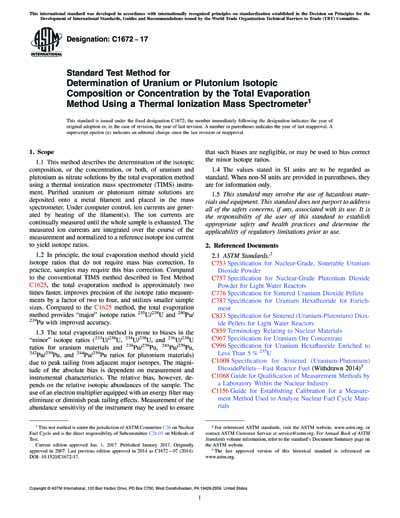Historical
ASTM C1672-17
Standard Test Method for Determination of Uranium or Plutonium Isotopic Composition or Concentration by the Total Evaporation Method Using a Thermal Ionization Mass Spectrometer
1.1 This method describes the determination of the isotopic composition, or the concentration, or both, of uranium and plutonium as nitrate solutions by the total evaporation method using a thermal ionization mass spectrometer (TIMS) instrument. Purified uranium or plutonium nitrate solutions are deposited onto a metal filament and placed in the mass spectrometer. Under computer control, ion currents are generated by heating of the filament(s). The ion currents are continually measured until the whole sample is exhausted. The measured ion currents are integrated over the course of the measurement and normalized to a reference isotope ion current to yield isotope ratios.
1.2 In principle, the total evaporation method should yield isotope ratios that do not require mass bias correction. In practice, samples may require this bias correction. Compared to the conventional TIMS method described in Test Method C1625, the total evaporation method is approximately two times faster, improves precision of the isotope ratio measurements by a factor of two to four, and utilizes smaller sample sizes. Compared to the C1625 method, the total evaporation method provides “major” isotope ratios 235U/238U and 240Pu/239Pu with improved accuracy.
1.3 The total evaporation method is prone to biases in the “minor” isotope ratios (233U/238U, 234U/238U, and 236U/238U ratios for uranium materials and 238Pu/239Pu, 241Pu/239Pu, 242Pu/239Pu, and 244Pu/239Pu ratios for plutonium materials) due to peak tailing from adjacent major isotopes. The magnitude of the absolute bias is dependent on measurement and instrumental characteristics. The relative bias, however, depends on the relative isotopic abundances of the sample. The use of an electron multiplier equipped with an energy filter may eliminate or diminish peak tailing effects. Measurement of the abundance sensitivity of the instrument may be used to ensure that such biases are negligible, or may be used to bias correct the minor isotope ratios.
1.4 The values stated in SI units are to be regarded as standard. When non-SI units are provided in parentheses, they are for information only.
1.5 This standard may involve the use of hazardous materials and equipment. This standard does not purport to address all of the safety concerns, if any, associated with its use. It is the responsibility of the user of this standard to establish appropriate safety and health practices and determine the applicability of regulatory limitations prior to use.
Content Provider
ASTM International [astm]






